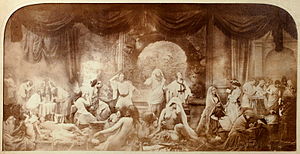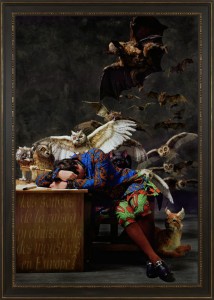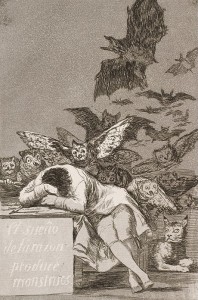Cultural Cocktail Hour
Review: Oscar Rejlander and Reenactment in Contemporary Photography at the Getty Center
Oscar Rejlander: Artist Photographer
Encore: Reenactment in Contemporary Photography
On View March 12-June 9, 2019
By
Leticia Marie Sanchez
With the advent of I-phones, Instagram, and social media, photography is the artistic medium most often at people’s fingertips. Aided by the use of filters, users attempt to curate frothy artistic images out of everyday items like cups of Espresso or Pumpkin Chai.
But photography was not always viewed as an artistic medium on par with Fine Arts like painting and sculpture.
The Getty Center’s new exhibit Oscar Rejlander: Artist Photographer sheds light on an artist who became known as “the father of art photography.”
The exhibition, curated by Lori Pauli, curator of photographs at the National Gallery of Canada, and Karen Hellman, assistant curator of photographs at the J. Paul Getty Museum, is comprised of 150 photographs and includes images of some of the most seminal figures of the day including Charles Darwin, Lewis Carroll, and Julia Margaret Cameron. Rejlander worked first as a painter before experimenting with photography. His photographs exude a painterly quality, particularly in the pose of the sitters. For instance, Non Angeli sed Angli (Not Angels but Anglos), alludes to the cherubim in Raphael’s Sistine Madonna.

Oscar Gustaf Rejlander
British, born Sweden, 1813-1875. Non Angeli sed Angli (Not Angels but Anglos), after Raphael’s Sistine Madonna, about 1854-1856.
Albumen silver print
Image: 20.5 X 26.3 cm (8 1/16 X 10 3/8 in.) Princeton University Art Museum. Museum purchase. David H. Mc Alpin. Class of 1920. Fund. EX.2019.5.91
The exhibit is filled with works that shed light on the time period. One of the most hilarious photographs is Rejlander clad as Italian nationalist and general Giuseppe Garibaldi. At the time, Garibaldi was a world superstar with legions of fans. Apparently, the emulation of celebrities is nothing new.

Another Rejlander work not to be missed is the epic photograph, the Two Ways of Life, or Hope in Repentance. Similar to Angeli sed Angli , this work was influenced by Raphael. The composition of the Way of Life alludes to Raphael’s School of Athens. The photograph is a complex allegory of two divergent paths in life, the road of Vice and the road of Virtue. The ghastly portrayal of vice includes dark and depressing depictions of those spiraling into a world of gambling, idleness, and desire. The uplifting portrayal of Virtue includes orderly depictions of industriousness, education, and religion. What was avant-garde for the time was Rejlander’s technique of combination printing. This process involved the combination printing of over 30 separate wet collodion on glass negatives, a technique which took more than three days. The Two Ways of Life is considered one of the finest examples of combination printing from this era.
As a companion exhibit, Encore: Reenactment in Contemporary Photography depicts the reimaging of events for the camera as a means to explore historical art narratives. The visually arresting exhibit includes works by seven photographers: Eileen Cowin, Christina Fernandez, Samuel Fosso, Yasumasa Morimura, Yinka Shonibare CBE, Gillian Wearing, and Qiu Zhijie.
Highlights of the Encore: Reenactment in Contemporary Photography Exhibit include:

Yinka Shonibare, CBE
The Sleep of Reason Produces Monsters (America) 2008
Chromogenic print
Image: 182 X 125.9cm (71 5/8 X 49 9/16 in.) Collection of Michael W. Rabkin and Chip Tom. © Yinka Shonibare CBE. Courtesy James Cohan, New York. EX. 2019.4.2
Based on a Goya etching, the “reenactment” helps one to better understand the horror in the original Goya etching.
Just as color functions to highlight emotions in German Expressionist paintings, the vibrant color in Shonibare’s work intensifies the experience of the work.
The original Goya is accompanied by the following epigraph: “Fantasy abandoned by reason produces impossible monsters: united with her (reason), she (fantasy) is the mother of the arts and the origin of their marvels.” Viewiing Shonibare’s work, the frightful monsters are experienced in a bright, visceral way, the bats flying straight towards the viewer, making the original Goya etching pale in comparison to the visceral, three-dimensional impact.

he Sleep of Reason Produces Monsters by Francisco Goya; c. 1799
Etching, aquatint, drypoint and burin
Dimensions 21.5 cm × 15 cm (8 7⁄16 in × 5 7⁄8 in)
Location Metropolitan Museum of Art, New York

Another highlight in the Reenactment exhibit is Christina Fernandez’ photographic narrative depicting her great grandmother’s migration to the United States. In this reenactment Fernandez photographed herself as the character of her great-grandmother. Fernandez’ narrative has a cinematic quality: the various stages of her intrepid grandmother’s odyssey are depicted in black and white. The last image, the only one in color, emerges like a burst of Technicolor, possibly depicting the artist herself, safely ensconced in her middle-class 1950’s home, a comfortable life only made possible due to the sacrifice of her great-grandmother.Christina Fernandez, American, born 1965, 1927, Going back to Morelia, 1995-1996; Gelatin Silver Print. Image: 44.8 X 30.5cm (17 5/8 x 12 in.) The J. Paul Getty Museum, Los Angeles © Christina Fernandez 2014 37.3
Both of the exhibits challenge the viewer to look at photography in a new light, one in which art historical narratives shaped the camera lens.













